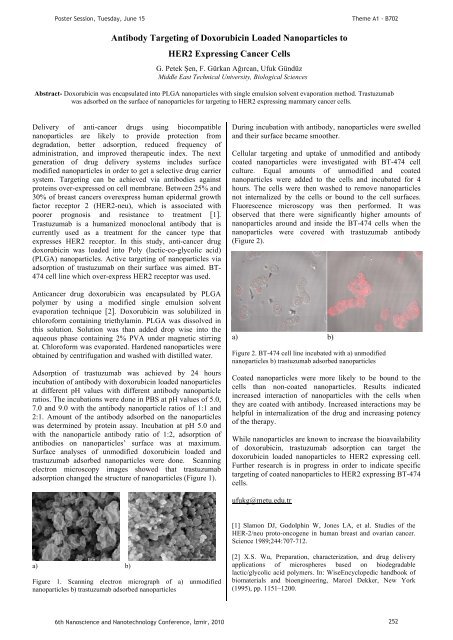Photonic crystals in biology
Photonic crystals in biology
Photonic crystals in biology
Create successful ePaper yourself
Turn your PDF publications into a flip-book with our unique Google optimized e-Paper software.
Poster Session, Tuesday, June 15<br />
Theme A1 - B702<br />
Antibody Target<strong>in</strong>g of Doxorubic<strong>in</strong> Loaded Nanoparticles to<br />
HER2 Express<strong>in</strong>g Cancer Cells<br />
G. Petek en, F. Gürkan A ırcan, Ufuk Gündüz<br />
Middle East Technical University, Biological Sciences<br />
Abstract- Doxorubic<strong>in</strong> was encapsulated <strong>in</strong>to PLGA nanoparticles with s<strong>in</strong>gle emulsion solvent evaporation method. Trastuzumab<br />
was adsorbed on the surface of nanoparticles for target<strong>in</strong>g to HER2 express<strong>in</strong>g mammary cancer cells.<br />
Delivery of anti-cancer drugs us<strong>in</strong>g biocompatible<br />
nanoparticles are likely to provide protection from<br />
degradation, better adsorption, reduced frequency of<br />
adm<strong>in</strong>istration, and improved therapeutic <strong>in</strong>dex. The next<br />
generation of drug delivery systems <strong>in</strong>cludes surface<br />
modified nanoparticles <strong>in</strong> order to get a selective drug carrier<br />
system. Target<strong>in</strong>g can be achieved via antibodies aga<strong>in</strong>st<br />
prote<strong>in</strong>s over-expressed on cell membrane. Between 25% and<br />
30% of breast cancers overexpress human epidermal growth<br />
factor receptor 2 (HER2-neu), which is associated with<br />
poorer prognosis and resistance to treatment [1].<br />
Trastuzumab is a humanized monoclonal antibody that is<br />
currently used as a treatment for the cancer type that<br />
expresses HER2 receptor. In this study, anti-cancer drug<br />
doxorubic<strong>in</strong> was loaded <strong>in</strong>to Poly (lactic-co-glycolic acid)<br />
(PLGA) nanoparticles. Active target<strong>in</strong>g of nanoparticles via<br />
adsorption of trastuzumab on their surface was aimed. BT-<br />
474 cell l<strong>in</strong>e which over-express HER2 receptor was used.<br />
Anticancer drug doxorubic<strong>in</strong> was encapsulated by PLGA<br />
polymer by us<strong>in</strong>g a modified s<strong>in</strong>gle emulsion solvent<br />
evaporation technique [2]. Doxorubic<strong>in</strong> was solubilized <strong>in</strong><br />
chloroform conta<strong>in</strong><strong>in</strong>g triethylam<strong>in</strong>. PLGA was dissolved <strong>in</strong><br />
this solution. Solution was than added drop wise <strong>in</strong>to the<br />
aqueous phase conta<strong>in</strong><strong>in</strong>g 2% PVA under magnetic stirr<strong>in</strong>g<br />
at. Chloroform was evaporated. Hardened nanoparticles were<br />
obta<strong>in</strong>ed by centrifugation and washed with distilled water.<br />
Adsorption of trastuzumab was achieved by 24 hours<br />
<strong>in</strong>cubation of antibody with doxorubic<strong>in</strong> loaded nanoparticles<br />
at different pH values with different antibody nanoparticle<br />
ratios. The <strong>in</strong>cubations were done <strong>in</strong> PBS at pH values of 5.0,<br />
7.0 and 9.0 with the antibody nanoparticle ratios of 1:1 and<br />
2:1. Amount of the antibody adsorbed on the nanoparticles<br />
was determ<strong>in</strong>ed by prote<strong>in</strong> assay. Incubation at pH 5.0 and<br />
with the nanoparticle antibody ratio of 1:2, adsorption of<br />
antibodies on nanoparticles’ surface was at maximum.<br />
Surface analyses of unmodified doxorubic<strong>in</strong> loaded and<br />
trastuzumab adsorbed nanoparticles were done. Scann<strong>in</strong>g<br />
electron microscopy images showed that trastuzumab<br />
adsorption changed the structure of nanoparticles (Figure 1).<br />
Dur<strong>in</strong>g <strong>in</strong>cubation with antibody, nanoparticles were swelled<br />
and their surface became smoother.<br />
Cellular target<strong>in</strong>g and uptake of unmodified and antibody<br />
coated nanoparticles were <strong>in</strong>vestigated with BT-474 cell<br />
culture. Equal amounts of unmodified and coated<br />
nanoparticles were added to the cells and <strong>in</strong>cubated for 4<br />
hours. The cells were then washed to remove nanoparticles<br />
not <strong>in</strong>ternalized by the cells or bound to the cell surfaces.<br />
Fluorescence microscopy was then performed. It was<br />
observed that there were significantly higher amounts of<br />
nanoparticles around and <strong>in</strong>side the BT-474 cells when the<br />
nanoparticles were covered with trastuzumab antibody<br />
(Figure 2).<br />
a) b)<br />
Figure 2. BT-474 cell l<strong>in</strong>e <strong>in</strong>cubated with a) unmodified<br />
nanoparticles b) trastuzumab adsorbed nanoparticles<br />
Coated nanoparticles were more likely to be bound to the<br />
cells than non-coated nanoparticles. Results <strong>in</strong>dicated<br />
<strong>in</strong>creased <strong>in</strong>teraction of nanoparticles with the cells when<br />
they are coated with antibody. Increased <strong>in</strong>teractions may be<br />
helpful <strong>in</strong> <strong>in</strong>ternalization of the drug and <strong>in</strong>creas<strong>in</strong>g potency<br />
of the therapy.<br />
While nanoparticles are known to <strong>in</strong>crease the bioavailability<br />
of doxorubic<strong>in</strong>, trastuzumab adsorption can target the<br />
doxorubic<strong>in</strong> loaded nanoparticles to HER2 express<strong>in</strong>g cell.<br />
Further research is <strong>in</strong> progress <strong>in</strong> order to <strong>in</strong>dicate specific<br />
target<strong>in</strong>g of coated nanoparticles to HER2 express<strong>in</strong>g BT-474<br />
cells.<br />
ufukg@metu.edu.tr<br />
[1] Slamon DJ, Godolph<strong>in</strong> W, Jones LA, et al. Studies of the<br />
HER-2/neu proto-oncogene <strong>in</strong> human breast and ovarian cancer.<br />
Science 1989;244:707-712.<br />
a) b)<br />
Figure 1. Scann<strong>in</strong>g electron micrograph of a) unmodified<br />
nanoparticles b) trastuzumab adsorbed nanoparticles<br />
[2] X.S. Wu, Preparation, characterization, and drug delivery<br />
applications of microspheres based on biodegradable<br />
lactic/glycolic acid polymers. In: WiseEncyclopedic handbook of<br />
biomaterials and bioeng<strong>in</strong>eer<strong>in</strong>g, Marcel Dekker, New York<br />
(1995), pp. 1151–1200.<br />
6th Nanoscience and Nanotechnology Conference, zmir, 2010 252













